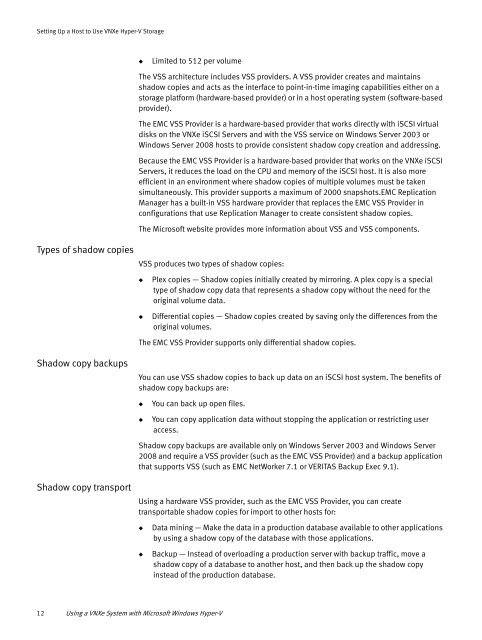Using a VNXe System with Microsoft Windows Hyper-V - EMC ...
Using a VNXe System with Microsoft Windows Hyper-V - EMC ...
Using a VNXe System with Microsoft Windows Hyper-V - EMC ...
Create successful ePaper yourself
Turn your PDF publications into a flip-book with our unique Google optimized e-Paper software.
Setting Up a Host to Use <strong>VNXe</strong> <strong>Hyper</strong>-V Storage◆Limited to 512 per volumeThe VSS architecture includes VSS providers. A VSS provider creates and maintainsshadow copies and acts as the interface to point-in-time imaging capabilities either on astorage platform (hardware-based provider) or in a host operating system (software-basedprovider).The <strong>EMC</strong> VSS Provider is a hardware-based provider that works directly <strong>with</strong> iSCSI virtualdisks on the <strong>VNXe</strong> iSCSI Servers and <strong>with</strong> the VSS service on <strong>Windows</strong> Server 2003 or<strong>Windows</strong> Server 2008 hosts to provide consistent shadow copy creation and addressing.Because the <strong>EMC</strong> VSS Provider is a hardware-based provider that works on the <strong>VNXe</strong> iSCSIServers, it reduces the load on the CPU and memory of the iSCSI host. It is also moreefficient in an environment where shadow copies of multiple volumes must be takensimultaneously. This provider supports a maximum of 2000 snapshots.<strong>EMC</strong> ReplicationManager has a built-in VSS hardware provider that replaces the <strong>EMC</strong> VSS Provider inconfigurations that use Replication Manager to create consistent shadow copies.The <strong>Microsoft</strong> website provides more information about VSS and VSS components.Types of shadow copiesVSS produces two types of shadow copies:◆◆Plex copies — Shadow copies initially created by mirroring. A plex copy is a specialtype of shadow copy data that represents a shadow copy <strong>with</strong>out the need for theoriginal volume data.Differential copies — Shadow copies created by saving only the differences from theoriginal volumes.The <strong>EMC</strong> VSS Provider supports only differential shadow copies.Shadow copy backupsYou can use VSS shadow copies to back up data on an iSCSI host system. The benefits ofshadow copy backups are:◆◆You can back up open files.You can copy application data <strong>with</strong>out stopping the application or restricting useraccess.Shadow copy backups are available only on <strong>Windows</strong> Server 2003 and <strong>Windows</strong> Server2008 and require a VSS provider (such as the <strong>EMC</strong> VSS Provider) and a backup applicationthat supports VSS (such as <strong>EMC</strong> NetWorker 7.1 or VERITAS Backup Exec 9.1).Shadow copy transport<strong>Using</strong> a hardware VSS provider, such as the <strong>EMC</strong> VSS Provider, you can createtransportable shadow copies for import to other hosts for:◆◆Data mining — Make the data in a production database available to other applicationsby using a shadow copy of the database <strong>with</strong> those applications.Backup — Instead of overloading a production server <strong>with</strong> backup traffic, move ashadow copy of a database to another host, and then back up the shadow copyinstead of the production database.12 <strong>Using</strong> a <strong>VNXe</strong> <strong>System</strong> <strong>with</strong> <strong>Microsoft</strong> <strong>Windows</strong> <strong>Hyper</strong>-V
















